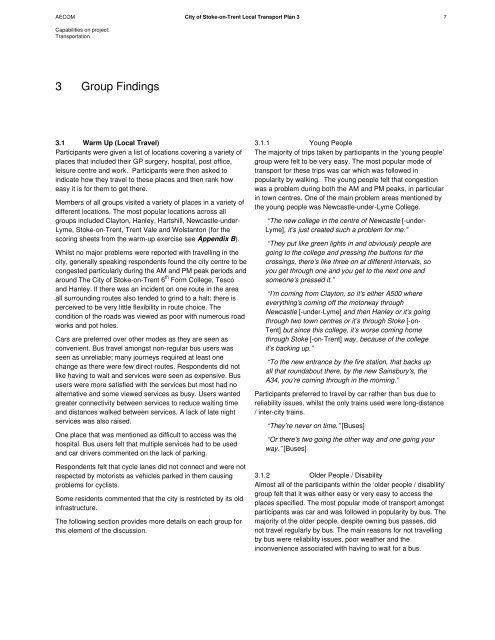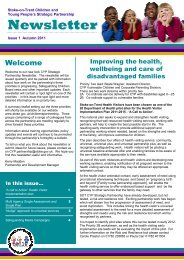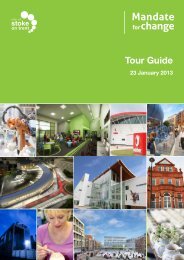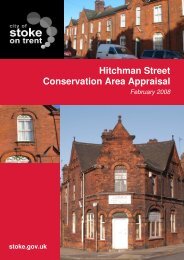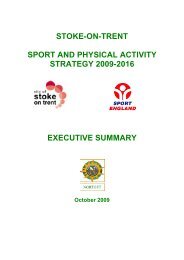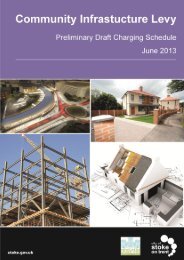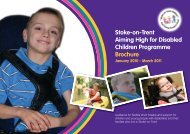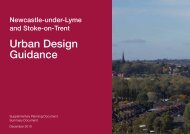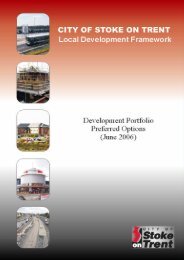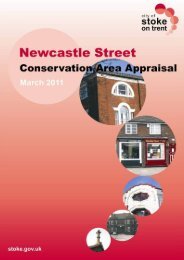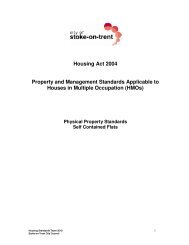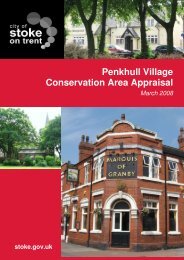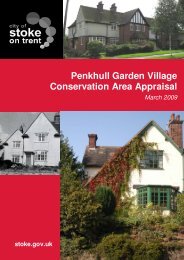City of Stoke-on-Trent Local Transport Plan 3 Focus Groups
City of Stoke-on-Trent Local Transport Plan 3 Focus Groups
City of Stoke-on-Trent Local Transport Plan 3 Focus Groups
- No tags were found...
You also want an ePaper? Increase the reach of your titles
YUMPU automatically turns print PDFs into web optimized ePapers that Google loves.
AECOM <str<strong>on</strong>g>City</str<strong>on</strong>g> <str<strong>on</strong>g>of</str<strong>on</strong>g> <str<strong>on</strong>g>Stoke</str<strong>on</strong>g>-<strong>on</strong>-<strong>Trent</strong> <strong>Local</strong> <strong>Transport</strong> <strong>Plan</strong> 3 7Capabilities <strong>on</strong> project:<strong>Transport</strong>ati<strong>on</strong>3 Group Findings3.1 Warm Up (<strong>Local</strong> Travel)Participants were given a list <str<strong>on</strong>g>of</str<strong>on</strong>g> locati<strong>on</strong>s covering a variety <str<strong>on</strong>g>of</str<strong>on</strong>g>places that included their GP surgery, hospital, post <str<strong>on</strong>g>of</str<strong>on</strong>g>fice,leisure centre and work. Participants were then asked toindicate how they travel to these places and then rank howeasy it is for them to get there.Members <str<strong>on</strong>g>of</str<strong>on</strong>g> all groups visited a variety <str<strong>on</strong>g>of</str<strong>on</strong>g> places in a variety <str<strong>on</strong>g>of</str<strong>on</strong>g>different locati<strong>on</strong>s. The most popular locati<strong>on</strong>s across allgroups included Clayt<strong>on</strong>, Hanley, Hartshill, Newcastle-under-Lyme, <str<strong>on</strong>g>Stoke</str<strong>on</strong>g>-<strong>on</strong>-<strong>Trent</strong>, <strong>Trent</strong> Vale and Wolstant<strong>on</strong> (for thescoring sheets from the warm-up exercise see Appendix B).Whilst no major problems were reported with travelling in thecity, generally speaking resp<strong>on</strong>dents found the city centre to bec<strong>on</strong>gested particularly during the AM and PM peak periods andaround The <str<strong>on</strong>g>City</str<strong>on</strong>g> <str<strong>on</strong>g>of</str<strong>on</strong>g> <str<strong>on</strong>g>Stoke</str<strong>on</strong>g>-<strong>on</strong>-<strong>Trent</strong> 6 th Form College, Tescoand Hanley. If there was an incident <strong>on</strong> <strong>on</strong>e route in the areaall surrounding routes also tended to grind to a halt; there isperceived to be very little flexibility in route choice. Thec<strong>on</strong>diti<strong>on</strong> <str<strong>on</strong>g>of</str<strong>on</strong>g> the roads was viewed as poor with numerous roadworks and pot holes.Cars are preferred over other modes as they are seen asc<strong>on</strong>venient. Bus travel am<strong>on</strong>gst n<strong>on</strong>-regular bus users wasseen as unreliable; many journeys required at least <strong>on</strong>echange as there were few direct routes. Resp<strong>on</strong>dents did notlike having to wait and services were seen as expensive. Bususers were more satisfied with the services but most had noalternative and some viewed services as busy. Users wantedgreater c<strong>on</strong>nectivity between services to reduce waiting timeand distances walked between services. A lack <str<strong>on</strong>g>of</str<strong>on</strong>g> late nightservices was also raised.One place that was menti<strong>on</strong>ed as difficult to access was thehospital. Bus users felt that multiple services had to be usedand car drivers commented <strong>on</strong> the lack <str<strong>on</strong>g>of</str<strong>on</strong>g> parking.Resp<strong>on</strong>dents felt that cycle lanes did not c<strong>on</strong>nect and were notrespected by motorists as vehicles parked in them causingproblems for cyclists.Some residents commented that the city is restricted by its oldinfrastructure.The following secti<strong>on</strong> provides more details <strong>on</strong> each group forthis element <str<strong>on</strong>g>of</str<strong>on</strong>g> the discussi<strong>on</strong>.3.1.1 Young PeopleThe majority <str<strong>on</strong>g>of</str<strong>on</strong>g> trips taken by participants in the ‘young people’group were felt to be very easy. The most popular mode <str<strong>on</strong>g>of</str<strong>on</strong>g>transport for these trips was car which was followed inpopularity by walking. The young people felt that c<strong>on</strong>gesti<strong>on</strong>was a problem during both the AM and PM peaks, in particularin town centres. One <str<strong>on</strong>g>of</str<strong>on</strong>g> the main problem areas menti<strong>on</strong>ed bythe young people was Newcastle-under-Lyme College.“The new college in the centre <str<strong>on</strong>g>of</str<strong>on</strong>g> Newcastle [-under-Lyme], it’s just created such a problem for me.”“They put like green lights in and obviously people aregoing to the college and pressing the butt<strong>on</strong>s for thecrossings, there’s like three <strong>on</strong> at different intervals, soyou get through <strong>on</strong>e and you get to the next <strong>on</strong>e andsome<strong>on</strong>e’s pressed it.”“I’m coming from Clayt<strong>on</strong>, so it’s either A500 whereeverything’s coming <str<strong>on</strong>g>of</str<strong>on</strong>g>f the motorway throughNewcastle [-under-Lyme] and then Hanley or it’s goingthrough two town centres or it’s through <str<strong>on</strong>g>Stoke</str<strong>on</strong>g> [-<strong>on</strong>-Tent] but since this college, it’s worse coming homethrough <str<strong>on</strong>g>Stoke</str<strong>on</strong>g> [-<strong>on</strong>-<strong>Trent</strong>] way, because <str<strong>on</strong>g>of</str<strong>on</strong>g> the collegeit’s backing up.”“To the new entrance by the fire stati<strong>on</strong>, that backs upall that roundabout there, by the new Sainsbury's, theA34, you’re coming through in the morning.”Participants preferred to travel by car rather than bus due toreliability issues, whilst the <strong>on</strong>ly trains used were l<strong>on</strong>g-distance/ inter-city trains.“They’re never <strong>on</strong> time.” [Buses]“Or there’s two going the other way and <strong>on</strong>e going yourway.” [Buses]3.1.2 Older People / DisabilityAlmost all <str<strong>on</strong>g>of</str<strong>on</strong>g> the participants within the ‘older people / disability’group felt that it was either easy or very easy to access theplaces specified. The most popular mode <str<strong>on</strong>g>of</str<strong>on</strong>g> transport am<strong>on</strong>gstparticipants was car and was followed in popularity by bus. Themajority <str<strong>on</strong>g>of</str<strong>on</strong>g> the older people, despite owning bus passes, didnot travel regularly by bus. The main reas<strong>on</strong>s for not travellingby bus were reliability issues, poor weather and theinc<strong>on</strong>venience associated with having to wait for a bus.


